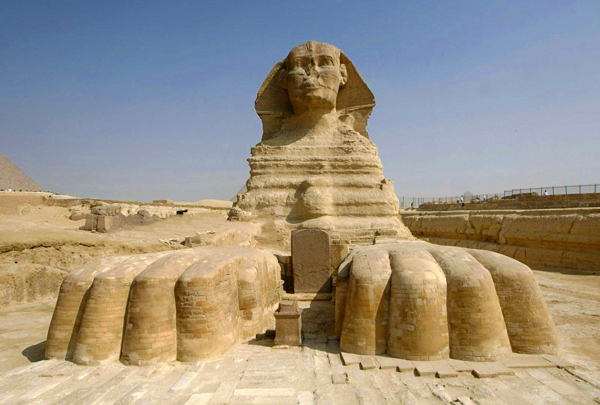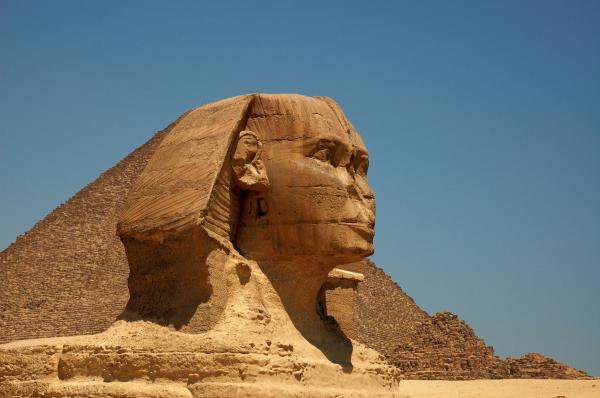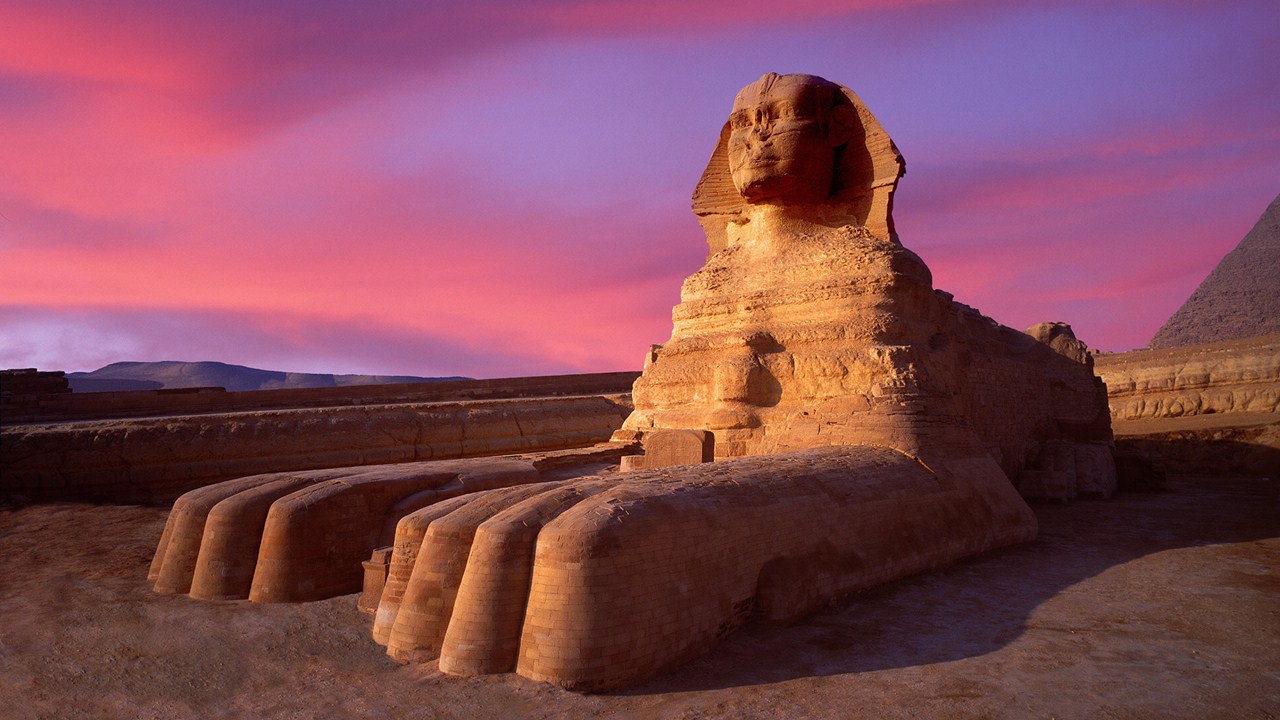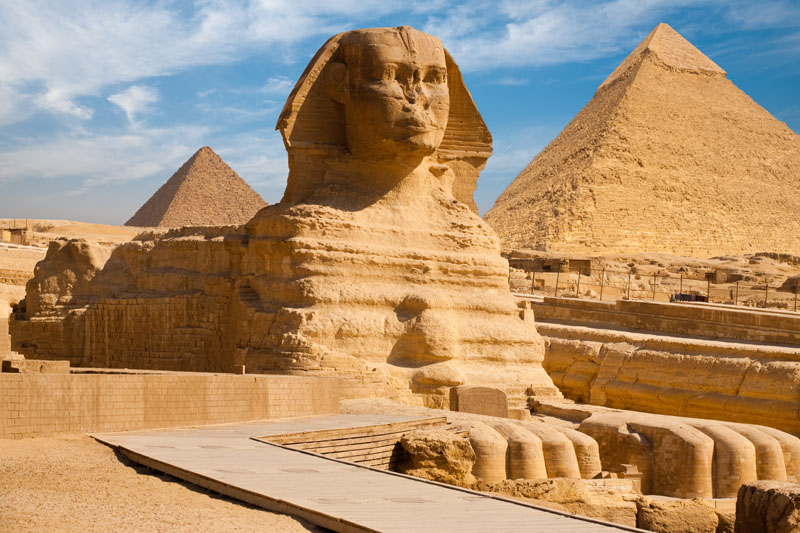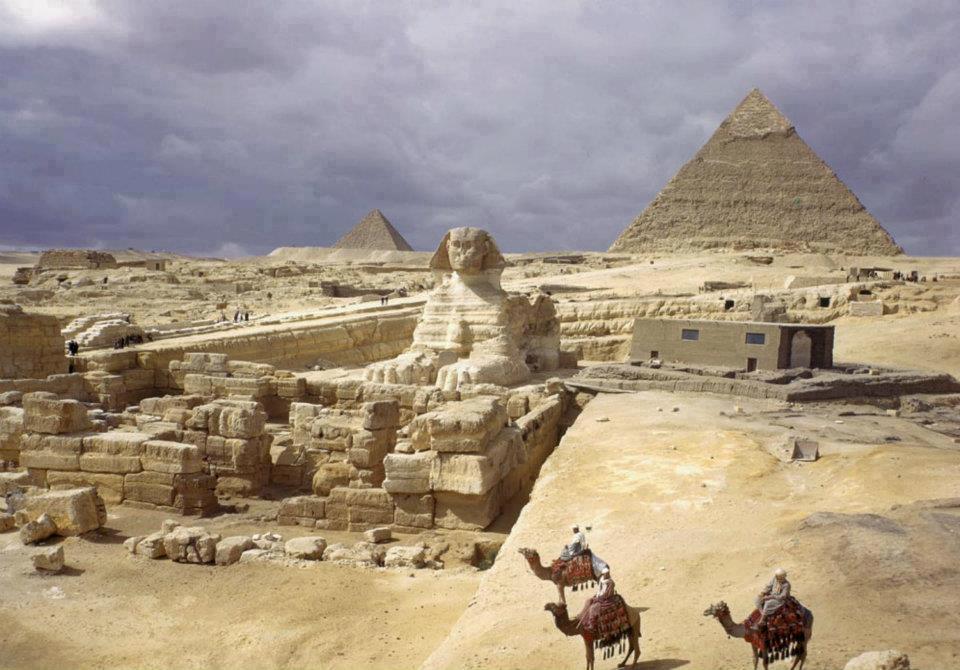The Great Sphinx of Giza (Arabic: أبو الهول Abū al-Haul, English: The Terrifying One; literally: Father of Dread), commonly referred to as the Sphinx, is a limestone statue of a reclining or couchant sphinx (a mythical creature with a lion's body and a human head) that stands on the Giza Plateau on the west bank of the Nile in Giza, Egypt. The face of the Sphinx is generally believed to represent the face of the Pharaoh Khafra.
It is the largest monolith statue in the world, standing 73.5 metres (241 ft) long, 19.3 metres (63 ft) wide, and 20.22 m (66.34 ft) high. It is the oldest known monumental sculpture, and is commonly believed to have been built by ancient Egyptians of the Old Kingdom during the reign of the Pharaoh Khafra (c. 2558–2532 BC).
The Great Sphinx is one of the world's largest and oldest statues but basic facts about it are still subject to debate, such as when it was built, by whom, and for what purpose. These questions have resulted in the popular idea of the "Riddle of the Sphinx", alluding to the original Greek legend of the Riddle of the Sphinx.
Pliny the Elder mentioned the Great Sphinx in his book, Natural History, commenting that the Egyptians looked upon the statue as a "divinity" that has been passed over in silence and "that King Harmais was buried in it".
Names of the Sphinx
It is not known by what name the creators called their statue, as the Great Sphinx does not appear in any known inscription of the Old Kingdom, and there are no inscriptions anywhere describing its construction or its original purpose. In the New Kingdom, the Sphinx was called Hor-em-akhet (English: Horus of the Horizon; Hellenized: Harmachis), and the pharaoh Thutmose IV (1401–1391 or 1397–1388 BC) specifically referred to it as such in his Dream Stele.
The commonly used name Sphinx was given to it in classical antiquity, about 2000 years after the commonly accepted date of its construction, by reference to a Greek mythological beast with a lion's body, a woman's head and the wings of an eagle (although, like most Egyptian sphinxes, the Great Sphinx has a man's head and no wings). The English word sphinx comes from the ancient Greek Σφίγξ (transliterated: sphinx), apparently from the verb σφίγγω (transliterated: sphingo / English: to squeeze), after the Greek sphinx who strangled anyone who failed to answer her riddle.
The name may alternatively be a linguistic corruption of the phonetically different ancient Egyptian word Ssp-anx (in Manuel de Codage). This name is given to royal statues of the Fourth dynasty of ancient Egypt (2575–2467 BC), and later in the New Kingdom (c. 1570–1070 BC) to the Great Sphinx more specifically.
Medieval Arab writers, including al-Maqrīzī, call the Sphinx balhib and bilhaw, which suggest a Coptic influence. The modern Egyptian Arabic name is أبو الهول (Abū al Hūl, English: The Terrifying One).
Modern dissenting hypotheses
Rainer Stadelmann, former director of the German Archaeological Institute in Cairo, examined the distinct iconography of the nemes (headdress) and the now-detached beard of the Sphinx and concluded that the style is more indicative of the Pharaoh Khufu (2589–2566 BC), builder of the Great Pyramid of Giza and Khafra's father. He supports this by suggesting that Khafra's Causeway was built to conform to a pre-existing structure, which, he concludes, given its location, could only have been the Sphinx.
Colin Reader, an English geologist who independently conducted a more recent survey of the enclosure, agrees that the various quarries on the site have been excavated around the Causeway. Because these quarries are known to have been used by Khufu, Reader concludes that the Causeway (and the temples on either end thereof) must predate Khufu, thereby casting doubt on the conventional Egyptian chronology.
In 2004, Vassil Dobrev of the Institut Français d'Archéologie Orientale in Cairo announced that he had uncovered new evidence that the Great Sphinx may have been the work of the little-known Pharaoh Djedefre (2528–2520 BC), Khafra's half brother and a son of Khufu. Dobrev suggests that Djedefre built the Sphinx in the image of his father Khufu, identifying him with the sun god Ra in order to restore respect for their dynasty. Dobrev also notes, like Stadelmann and others, that the causeway connecting Khafre's pyramid to the temples was built around the Sphinx suggesting it was already in existence at the time.
Images over the centuries
In the last 700 years, there has been a proliferation of travellers and reports from Lower Egypt, unlike Upper Egypt, which was seldom reported from prior to the mid-18th century. Alexandria, Rosetta, Damietta, Cairo and the Giza Pyramids are described repeatedly, but not necessarily comprehensively. Many accounts, by no means all by people who had actually seen it, were published and widely read. These include those of George Sandys, André Thévet, Athanasius Kircher, Balthasar de Monconys, Jean de Thévenot, John Greaves, Johann Michael Vansleb, Benoît de Maillet, Cornelis de Bruijn, Paul Lucas, Richard Pococke, Frederic Louis Norden and others. But there is an even larger crowd of more anonymous people who wrote obscure and little-read works, sometimes only unpublished manuscripts in libraries or private collections, including Henry Castela, Hans Ludwig von Lichtenstein, Michael Heberer von Bretten, Wilhelm von Boldensele, Pierre Belon du Mans, Vincent Stochove, Christophe Harant, Gilles Fermanel, Robert Fauvel, Jean Palerne Foresien, Willian Lithgow, Joos van Ghistele, etc.
Over the centuries, writers and scholars have recorded their impressions and reactions upon seeing the Sphinx. The vast majority were concerned with a general description, often including a mixture of science, romance and mystique. A typical description of the Sphinx by tourists and leisure travelers throughout the 19th and 20th century was made by John Lawson Stoddard:
It is the antiquity of the Sphinx which thrills us as we look upon it, for in itself it has no charms. The desert's waves have risen to its breast, as if to wrap the monster in a winding-sheet of gold. The face and head have been mutilated by Moslem fanatics. The mouth, the beauty of whose lips was once admired, is now expressionless. Yet grand in its loneliness, – veiled in the mystery of unnamed ages, – the relic of Egyptian antiquity stands solemn and silent in the presence of the awful desert – symbol of eternity. Here it disputes with Time the empire of the past; forever gazing on and on into a future which will still be distant when we, like all who have preceded us and looked upon its face, have lived our little lives and disappeared.
From the 16th century far into the 19th century, observers repeatedly noted that the Sphinx has the face, neck and breast of a woman. Examples included Johannes Helferich (1579), George Sandys (1615), Johann Michael Vansleb (1677), Benoît de Maillet (1735) and Elliot Warburton (1844).
Most early Western images were book illustrations in print form, elaborated by a professional engraver from either previous images available or some original drawing or sketch supplied by an author, and usually now lost. Seven years after visiting Giza, André Thévet (Cosmographie de Levant, 1556) described the Sphinx as "the head of a colossus, caused to be made by Isis, daughter of Inachus, then so beloved of Jupiter". He, or his artist and engraver, pictured it as a curly-haired monster with a grassy dog collar. Athanasius Kircher (who never visited Egypt) depicted the Sphinx as a Roman statue, reflecting his ability to conceptualize (Turris Babel, 1679). Johannes Helferich's (1579) Sphinx is a pinched-face, round-breasted woman with a straight haired wig; the only edge over Thevet is that the hair suggests the flaring lappets of the headdress. George Sandys stated that the Sphinx was a harlot; Balthasar de Monconys interpreted the headdress as a kind of hairnet, while François de La Boullaye-Le Gouz's Sphinx had a rounded hairdo with bulky collar.
Richard Pococke's Sphinx was an adoption of Cornelis de Bruijn's drawing of 1698, featuring only minor changes, but is closer to the actual appearance of the Sphinx than anything previous. The print versions of Norden's careful drawings for his Voyage d'Egypte et de Nubie, 1755 are the first to clearly show that the nose was missing. However, from the time of the Napoleonic invasion of Egypt onwards, a number of accurate images were widely available in Europe, and copied by others.
The Disney film Aladdin attributes the Sphinx's broken nose to a stonemason who accidentally chipped it off after being distracted by Aladdin and Jasmine flying past on their magic carpet during the song "A Whole New World". In the cartoon book Asterix and Cleopatra, Obelix climbs up the face of the Sphinx and accidentally knocks the nose off.




